Summary
Deja Vu – A Plane Spotting Challenge by John Madden
Catch up on the previous reports from this challenge:
Introduction
Trip Report #1
Trip Report #2
Trip Report #3
Trip Report #4
Trip Report #5
Trip Report #6
Trip Report #7
Trip Report #8
Trip Report #9
Trip Report #10
* Trip Report #11
27th-29th June 2024
Have no fear, you are not on the wrong website. The title merely highlights the 4 different modes of transport used during a recent spotting trip to Switzerland and Serbia. In June 2002 you may recall that I took a rental vehicle on a flat-bottomed roll-on roll-off car ferry across the river Elba when hunting down a VFW 614 in Northern Germany (Trip Report #7), but this is a first for using all 4 modes of transport in a single day.
When I first embarked upon this Challenge both Lucerne (Convair 990) and Belgrade (Short Sealand) originally featured on my list of must visit locations as day-trip spotting adventures. As trip reports came and went, it soon struck me that perhaps it would make sense to combine the two Museums in to a single spotting sortie. The question then arose, where to stop on the homeward leg from Belgrade and squeeze in an additional few hours’ spotting?
Like many aviation enthusiasts of my vintage, I have always had an emotional connection to 4 engine jet airliners. Standing in my school playground staring upwards at the daily wave of west bound Vickers VC10, Boeing 707, and Douglas DC8 overflights I could have been forgiven for believing that all aircraft had four engines. The fact was that when I started spotting most airliners were powered by four engines.
Then the Boeing 747 came along, a type that I followed from development to first flight with such excitement and anticipation. Knowing that I was a spotter, a neighbour kindly gifted me a postcard sent to her Travel Agency from Pan Am announcing the launch of trans-Atlantic Boeing 747 services. After many years pinned to my bedroom wall alongside other legends of the film and music worlds, this superb example of 1970s direct marketing may well look worse for wear but it still evokes fond memories I have of spotting this fabulous aircraft through the many decades that followed.

As did many spotters in 1970, I made the obligatory journey to Heathrow to log my first “Jumbo”. The 4-engine giganteum looked at home amongst all the other 4 engine airliners of the time, but the trend away from quad jets was soon upon us. Initially to 3 engines, but as we have all witnessed the availability of more powerful and reliable engines has led to the present day where the very capable ETOPs certified twin jets have become wearingly all too familiar.
With a former Swissair Convair 990 in Lucerne and the prospect of spotting Swiss Air Lines and Edelweiss Airbus A340-300s at Zurich airport, it seemed logical to swing home from Belgrade via another airport synonymous with quad jets. With few airports in Europe fitting the bill, the return journey from Belgrade to Heathrow would have to be via Frankfurt or Munich. A brief stopover at either airport would allow me to potentially log 6 different quad jet airliner types during a 3-day spotting trip. Not really a sub challenge, but an added spotting incentive to a trip that was expected to yield just 2 new aircraft on my Challenge list.
Not forgetting Serbia, the reason for visiting to the former Jugoslav Aeronautical Museum in Belgrade was to spot the twin engine amphibious Short Sealand SC6, a type that I had not seen before. Belgrade airport would also provide access to the wider Air Serbia fleet consisting of Embraer, ATR and wide body Airbus aircraft, very few of which frequent airports in the United Kingdom. Unlike most capital airports, Belgrade promised to be less of an open book in spotting terms and I was confident that the country’s past and present geo-political connections would add to the mix of unusual visitors.
A day at the races
Although it is only a couple of months since my last report, I did manage to squeeze in a most enjoyable morning’s spotting at the Ascot Heliport just half a mile from where I live. You guessed, it was Royal Ascot and the rotary circus came to town for the annual horse racing event in June. Each year a local farmer’s field comes out of hibernation and blossoms into a very busy heliport with in excess of 100 take off and landings per day over the 5-day racing calendar.
The heliport consists of a single 30m * 130m runway marked out for the event along with a handful of drop-off and go “ramps” in front of a large marquee that acts as a temporary terminal building. After depositing passengers, many of the helicopters relocate to the edges of the field until recalled for duties after racing has concluded. Spotting at this small tree enclosed location is quite exhilarating, especially so just prior to and after each day’s racing with helicopters often hovering above the “runway” waiting in turn for an available “ramp”. The organised chaos that unfolds directly in front of the designated spotting area is quite a spectacle and well worth a visit.
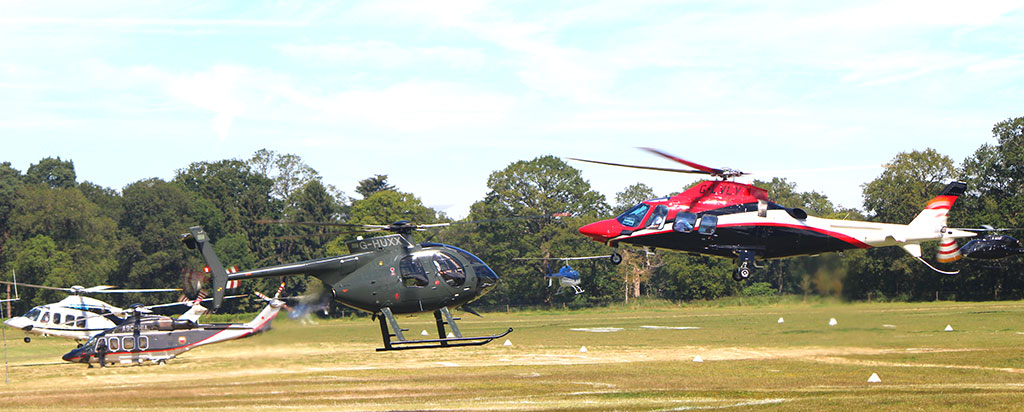
Is that the Ride of the Valkries I can hear?

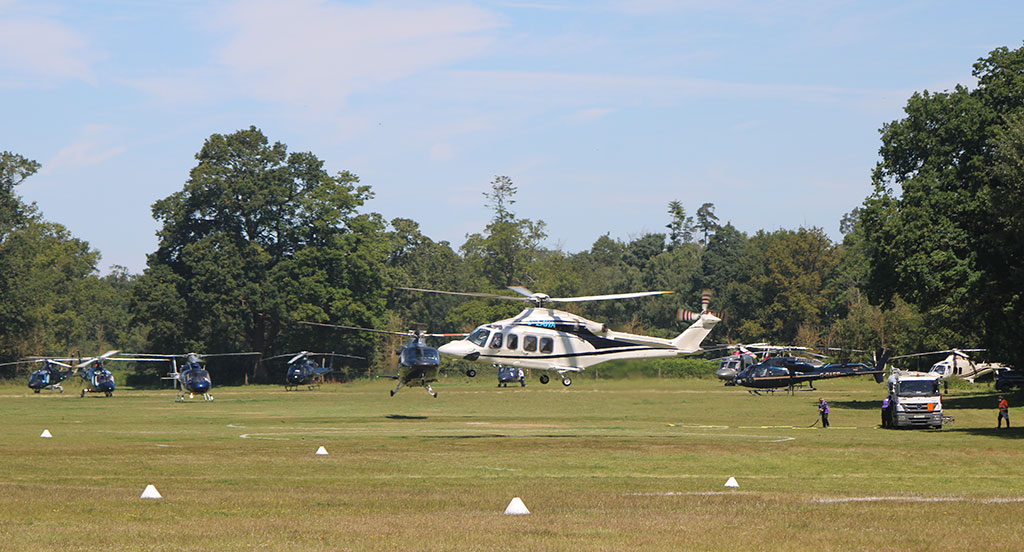
Queue waiting to use the refuelling lorry
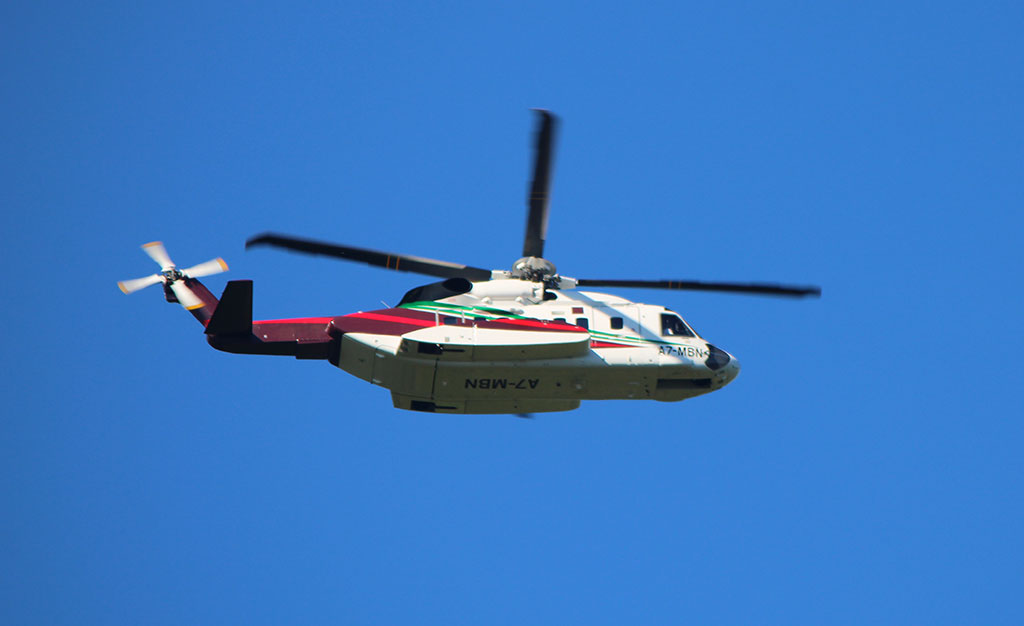
A7-MBN leaving Ascot races early, seen from my garden
Should you wish to visit the heliport during Ascot week, please reach out and I will be happy to guide you to the authorised spotting location. If you are interested in pageantry, let’s have tea and cake at the village hospitality tent and I will arrange a Royal procession.
Thursday 27th June: LX345 06:00 – Heathrow to Zurich
With tickets purchased for today’s journey, Mr. Jones and I arrived at Heathrow not just with our boarding passes for our Swiss Air Lines flight to Zurich, but also train tickets from Zurich airport to Lucerne plus our 2nd class steerage tickets for the short journey across lake Lucerne to the Swiss Museum of Transport. There are not many countries in the world where I would entrust a full day’s spotting to the timely operation of multiple modes of public transport, but Switzerland is one of them and today our precious log book is metaphorically speaking in the hands of the local train and ship operators.
I am very much looking forward to the opening flight sector of this spotting trip as our ride to Zurich will be on a new aircraft type for me, the Airbus A220. Having spotted a prototype Bombardier C Series aircraft at Montreal Hubert airport last year , I have waited eagerly for an opportunity to fly on the type and today’s aircraft is a series 300 registered HB-JCH.
It is a while since I first flew to Switzerland and that too was on an Airbus aircraft; the much larger A310-200 which at the time was deployed by Swissair on their intra continental network. After bringing the subject up on our short drive to Heathrow my spotting buddy produced an ace that well and truly trumped me; his first flight to Switzerland was aboard a BEA Airtours Comet 4, a quad jet type that I never had the pleasure of flying on.
A very warm welcome
Ordinarily there is nothing much to report when boarding an aircraft in today’s world, especially so when one has a seat at the rear of the cabin. But today’s experience is different and chapeau to Swiss for standing out in what has sadly become such a homogenised travel experience. Positioned at the forward entrance to the aircraft, the captain individually greeted each and every passenger as they boarded the aircraft. If I thought that was rather special, what happened just before push back raised the bar even higher. The captain re-appeared, stood with his back to the open flight deck and with intercom in hand addressed the entire cabin firstly in English and then in German. That is service with style.
And whist on the subject of style, the interior of the Swiss Airbus A220 is also worthy of acknowledgement. Although the aircraft for today’s flight is 6 years old, it still looks and feels like a freshly minted coin. The seats on this aircraft were manufactured by ZIM Aerospace GmbH, a company renowned for the manufacture of quality aircraft seating. Even in row 26, our economy seats were immaculately designed and finished to perfection. The tray table latch “clicked” purposely into place every time it was opened or closed. The seat back even had a small netted compartment for the stowage of your mobile phone, how handy is that and more importantly how thoughtful?
When disembarking the captain kindly invited me to have a quick look around the flight deck. For what many would describe as a small airliner, the flight deck struck me as surprisingly spacious and I would wager that it is larger than that of the Boeing 737 Max! Also of interest, and a first for me, was the head up display system which I had the privilege of receiving a live demonstration. All in all, my first Airbus A220 flight was truly memorable and confirmed the suspicion I already held that this is quite a remarkable aircraft for both the flight crew and passengers.

The hills are alive with the sound of …
Today’s itinerary kicks-off with a 3-hour spotting stint at Zurich airport. As the Observation Deck does not open until 10:00, we headed straight out of the Arrivals Hall in to the large shopping/eating complex adjacent to the terminal and took a lift to the top level of car park number P3. Exiting the lift, it was music to our ears that the only sound we could hear was that of airliners climbing away from the two runways in use today for departures. Whilst only two sides of the multi storey car park provide views across the airport, both are sufficient to spot traffic using runways 34-16 and 28-10, but not aircraft using runway 32-14. One of the airport’s several executive ramps is located directly opposite the car park and this one appears to be allocated to the larger of the visiting executive jets. All Swiss Air Lines, Helvetic and Edelweiss movements to and from the adjacent maintenance area are easily photographed from the car park.
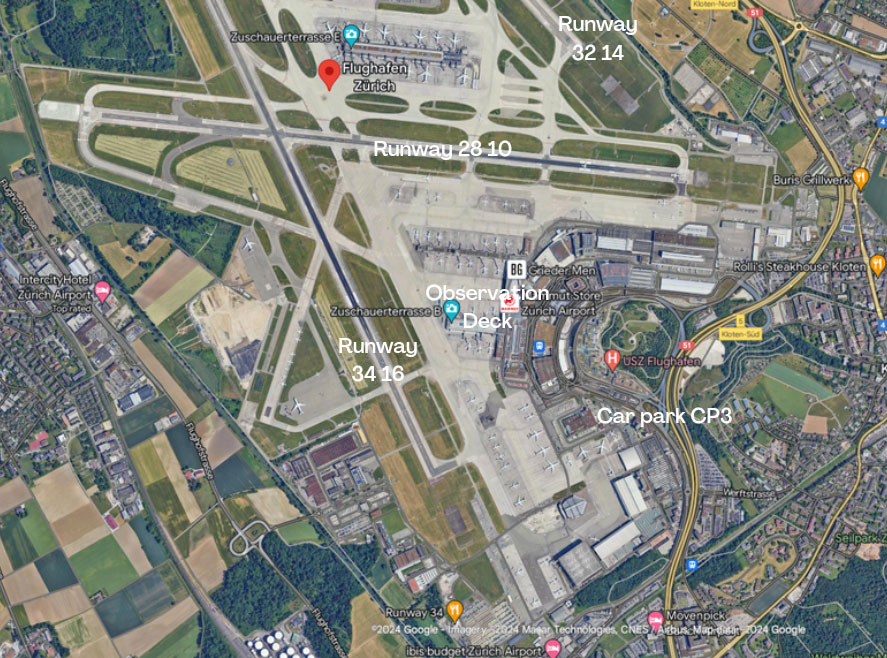
Zurich Airport map
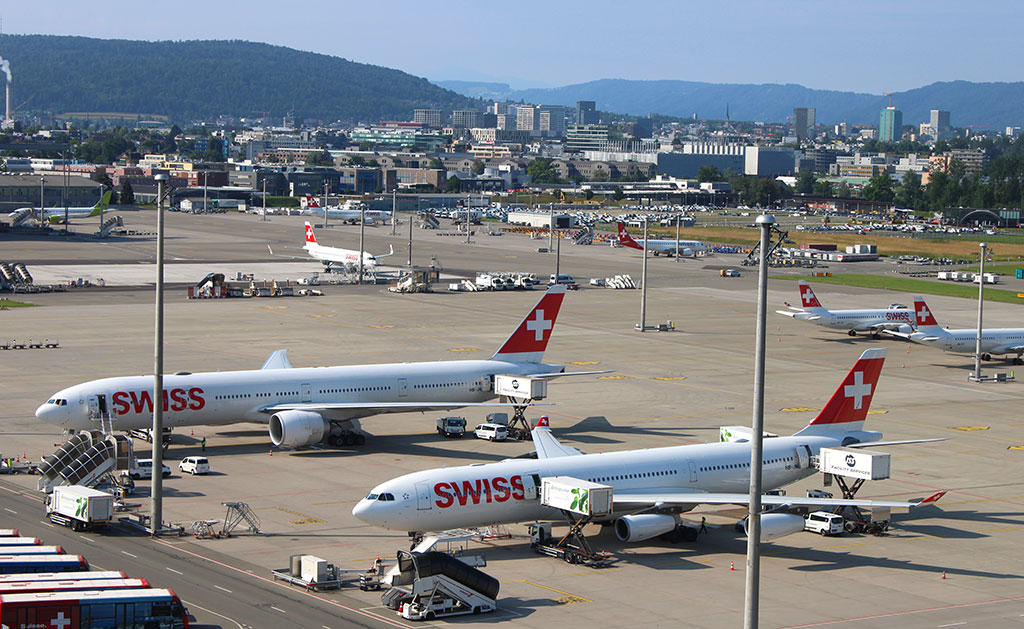
Maintenance area as viewed from car park P3
After an hour’s spotting, we made our way to the observation deck which is accessed through the Departure Hall in Terminal 1/2. Entrance is free of charge for passengers arriving or departing on the day, otherwise the cost if 3.5 CHF (approximately £3.20). When the flag dropped at 10:00 we were first through the airport-style security check and walked out on to an expansive and well-designed terrace, and what a great welcome greeted us. Lined up at the end of runway 34-16 and awaiting permission to roll was Swiss Airlines A340-300 HB-JMI.
From a spotting perspective the observation deck does have several blind spots, a second executive ramp at the end of runway 28-10 and the majority of Terminal 5 which is used by long-haul traffic. On the plus side however, all landing and departing aircraft can be spotted from the terrace even when all three runways are in operation. The following photograph is a good example of this with an Edelweiss A340-300 on finals to runway 32-14 with company A340-300 taxiing adjacent to runway 34-16 on its right and runway 28-10 running left to right just behind the aircraft.
After a very fruitful 2-hour spotting spree on the observation deck, it was time to depart for the Swiss Transport Museum in Lucerne and log the first of my spotting Challenge aircraft of this trip, a Swissair Convair 990. I especially enjoyed our morning’s spotting at Zurich airport, it is such a treat to have access to a purpose-built observation deck at such a large international airport. I added 5 Airbus A340-300s and 3 new airlines to the log book including the relatively new Swiss operator Chair. The following photographs were all taken from the observation deck.

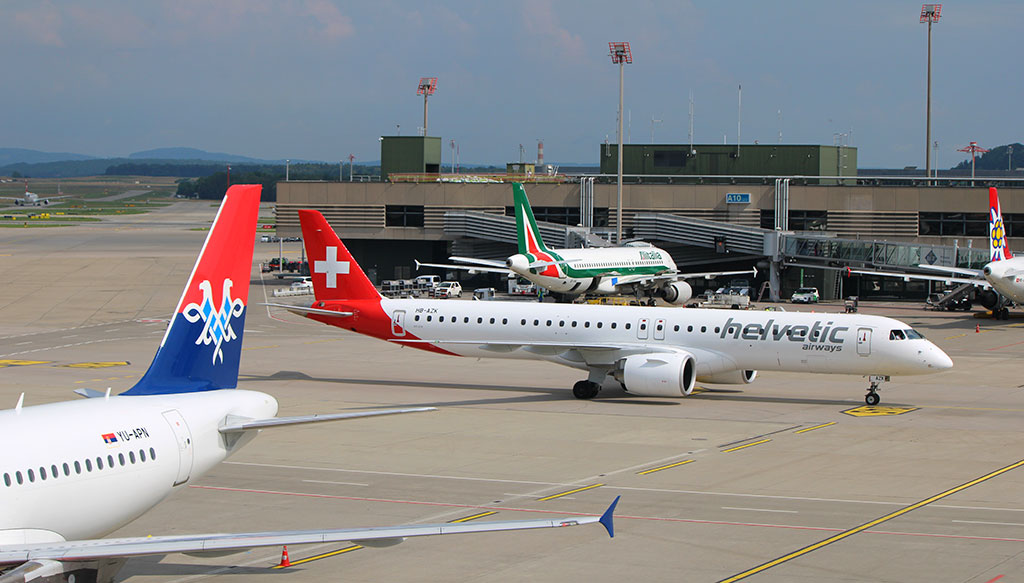
Helvetic Embraer 190 HB-AZK plus former Alitalia A320 EI-IKL

The public terrace is a must visit location and it offers unrivalled opportunities for photography, especially so for departing “heavies” that only used runway 34-16 during our visit. Being so close to the runway allows one to truly experience that unique aviation moment when an aircraft rotates and powers itself skywards, and that is one of the reasons why we do what we do as a hobby. If that wasn’t sufficient, the observation deck has all the amenities one would need including a large cafe, toilets and cover from the weather if required.

An Idyllic setting for an old lady
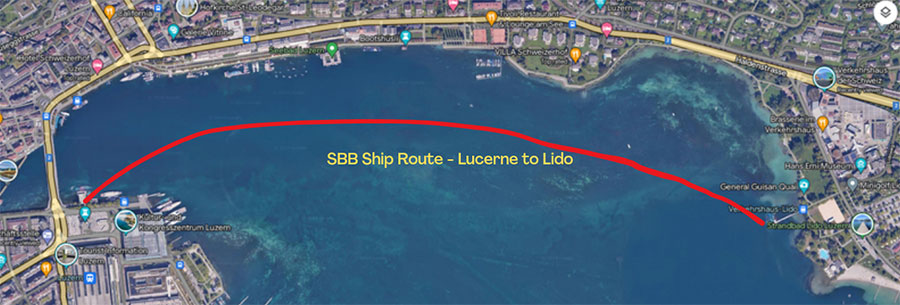
Lake Lucerne Map
As expected in the land famous for watch making, all elements of the 90-minute journey from Zurich airport to the Swiss Transport Museum in Lucerne performed like clockwork. Very soon we sat basking in the sun sailing across lake Lucerne with only a kitten’s cough of a breeze to detract from what was a splendid mid-afternoon temperature of 34c. As we approached the landing stage to disembark for the short walk to the Museum, a formation of 5 Pilatus PC21 trainers flew low overhead and we first heard and then spotted a pair of F18 Hornets disappearing behind one of the snow-covered mountains in the distance. I would highly recommend using the ship to reach the museum, it departs from Pier number 1 adjacent to the main bus/ railway station in Lucerne and your drop-off point is the Lido.
I have visited many museums in my search of long forgotten aircraft, but so far as location is concerned this one takes some beating. Situated just 200 meters from where we disembarked, one walks to the museum through a well-maintained lakeside park where people were swimming, playing beach volleyball and picnicking. Although promoted as a Transport Museum with numerous children friendly learning activities, the aviation component is very well thought out, immaculate in presentation and packs quite a punch for its size. Not surprisingly the exhibits span the development of Swiss aviation and all are without exception in immaculate condition.

Swissair Convair 990 HB-ICC
Access to both the Douglas DC-3 and Convair 990 is permitted and a must if you visit the museum. The interior of the Convair 990 is in perfect condition and the 1960s cabin layout is complete with period drinking/ smoking area neatly located between the first-class cabin and the flight deck.
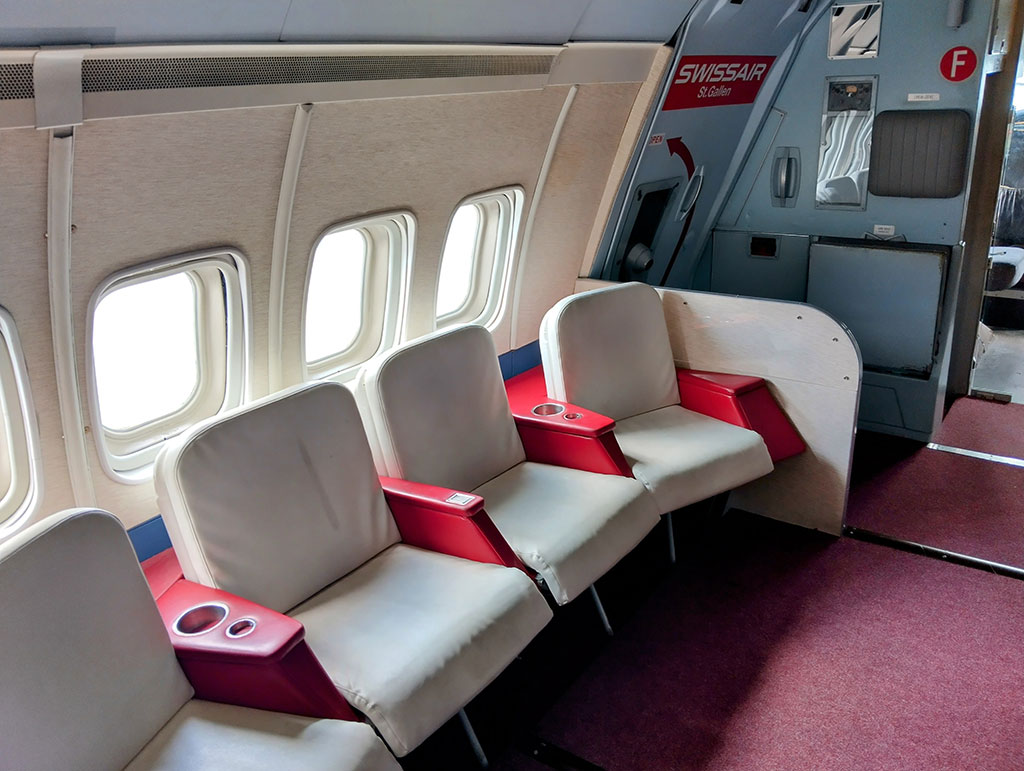
Another Martini, Mr. Bond?

I spotted my first Swissair 990 in 1971 on one of my early visits to Heathrow and I can remember how its sleek appearance always made it stand out amongst the quad jet crowd of the time. Not only did the Convair 990 look different, but I was convinced that it was fuelled by coal! As soon as the aircraft rotated the four General Electric turbo jets morphed into Lowry looking chimney stacks and the airport would remain shrouded in thick smoke long after the aircraft had departed for Switzerland. Although only operating a small fleet of just 7 aircraft, Swissair sadly lost a Convair 990 to terrorism in 1970 when an on-board bomb exploded soon after the aircraft had departed Zurich for Tel Aviv. A stark reminder that even being militarily neutral does not provide immunity against acts of terror.
I failed to spot HB-ICC before Swissair retired its Convair 990 fleet in 1975, so not only was this an opportunity to remove another type from the Challenge list but also a welcome addition to my log book. Today is a true “deja vu” moment, it is 42 years since I last spotted a Convair 990; N990E of Nomads Travel Company at Detroit Metro Airport.
With the Convair 990 scratched from the “wanted” list we retraced our steps back to Zurich airport. Not entirely step by step as we had two errands that needed addressing before leaving Lucerne. Firstly, I had a 100 CHF bank note left over from a family holiday to Switzerland in 2007 that I suspected was no longer legal tender. With a quick visit to the National Bank and following a no fee exchange for a 2024 model, we spent and I do mean “spent” the next few hours sampling the local craft beer and eating establishments of Lucerne before catching our train back to Zurich Airport.
The Night Cap
This is not a reference to the night time flight curfew imposed on Zurich airport, but a toast to the conclusion of a most enjoyable day’s spotting at the aptly named Runway 34 restaurant. The establishment advertises itself as “Das Flug Erbelnis Restaurant”, and truly does live up to the English translation “The flight experience restaurant”.
One enters the establishment through a short tunnel next to a menacingly looking former Swiss Air Force Mirage III. The tunnel is reminiscent of an air bridge and certainly adds to the overall aviation experience when entering the restaurant. Having passed through the tunnel one is welcomed by a member of staff and escorted to your seat. All staff wear flight deck style clothing and you are offered not only a food and drinks menu but also a Restaurant 34 inflight magazine.
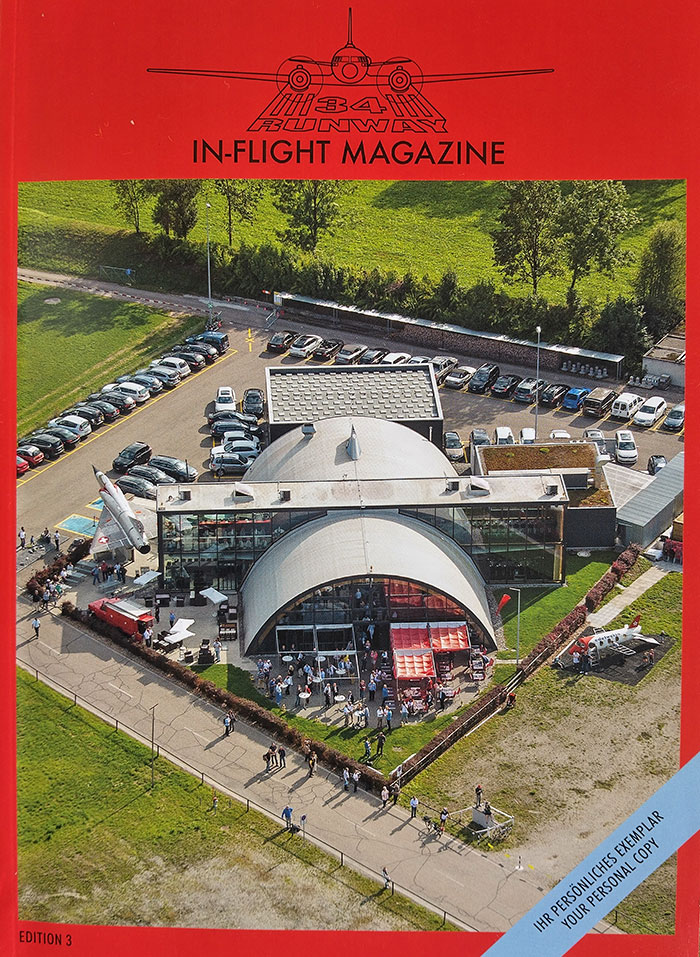
Runway 34 Restaurant In-Flight magazine
The building was purposely designed and built to fit like a glove around 67-year-old former Soviet Air Force Ilyushin IL-14 01146. After decommissioning in 1992, the aircraft was purchased by a private individual and remained in Russia until acquired by the owners of Runway 34 who flew the aircraft to Zurich Airport in 2002.
The IL-14 truly “owns” the restaurant and many of the formal dining tables are located beneath the aircraft’s fuselage and wings. Much of the restaurant furniture has been reclaimed from retired airliners and there is plenty of re purposed in flight galley equipment in use. The following photograph was taken from the more casual seating area located at the front of the building which looks out over Zurich airport including runway 34 and the airport maintenance area. The 8 blue coloured airline seats directly in front of the IL-14 originate from the business class section of an Edelweiss Airbus A330-200.
It came as no surprise to learn that the initiator and co-founder of Runway 34 had an illustrious aviation career, not only flying for Swissair and Emirates, but also as a former Swiss Air Force Mirage III pilot. There are few places where one can relax in re purposed airliner seats in the shadow of an immaculately preserved classic aircraft whilst watching modern airliners come and go from a major international airport. Well, that’s how we polished off day one of this spotting trip, quaffing a few weiss biers whilst adding to the ever-growing list of registrations accumulated at Zurich airport. We held our station until the sun dropped and it was time to hit the sack and contemplate what our trip to Serbia tomorrow may offer.
Friday 28th June: LX1412 07:20 – Zurich to Belgrade
Donner and Blitzen
Santa’s trusted reindeers did not make an airport appearance, but had they have done so I would have harnessed their magic and ensured that we departed for Belgrade on time. Any football fans amongst you may recall that the Germany and Denmark game played in Stuttgart was suspended due to an extraordinary thunder and lightning storm. That weather phenomenon passed over Zurich 36 hours earlier and we were woken up at 04:30 by a real Hooley of a thunderstorm that felt as if it was performing directly over our hotel. Braving our way to the airport in the lashing rain we discovered that all air side ground handling services had been suspended due to health and safety reasons and that our departure time to Belgrade had been pushed back several hours.
Leading up to today’s flight to Belgrade I had watched with interest the various aircraft types employed on this route by Swiss Airlines. Like many airlines with aircraft powered by P&W GTF engines, Swiss Airlines has been forced to reach out to third party airlines to maintain a full service. When I initially booked today’s flight our itinerary showed that we would be travelling on an Air Baltic A220-300. More recently the sector ebbed and flowed between an Air Baltic A220 and an E195 operated by Helvetic.
It came as a complete surprise to learn that not only would our flight to Belgrade today be operated by an A220 belonging to Swiss Air Lines, but indeed the very same one that brought us to Zurich. A quick check using a popular aviation application revealed that after delivering us to Zurich the aircraft had undertaken a return trip to both Valencia and Warsaw before night stopping at its home base. A different captain today for our flight to Belgrade, but the very same individual warm welcome and public address.
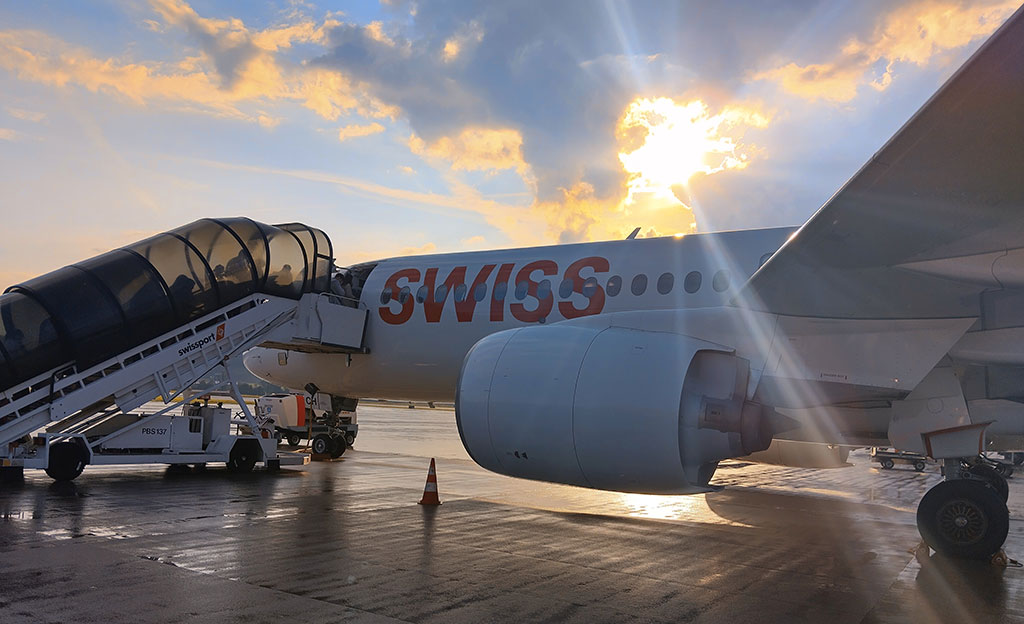
The sun finally shone over Zurich and we could depart for Belgrade
A sad place
The Aeronautical Museum is just a 10-minute walk from Belgrade airport and in its current form was opened in 1989. The museum building is one of the most exciting designs I have ever seen and is home to over 200 aircraft spanning Jugoslav and Serbian aeronautical history from the dawn of flight. The museum boasts that it is the only place on the planet where one can see a Spitfire, FW 190, and IL-2 Sturmovik displayed under the same roof, testimony to the complicated political allegiances that played out involving Yugoslavia during the 20th Century.
Soon after booking our flights to Belgrade, I learnt that the museum had temporarily closed for refurbishment. Not believing this might turn into an indefinite closure, I formulated the remainder of the spotting trip around Belgrade and things were set in stone. Several months later the museum informed me that there was no firm date for re-opening and that the refurbishment programme had not even commenced. After a momentary panic attack, I convinced myself that not all was lost as the Short Sealand is an open-air exhibit and should be visible from the perimeter fence. Visible though on one condition, that the new owners had not erected a 2-meter-high hoarding to protect the site during refurbishment.
After a tedious and time-consuming affair collecting our hire car, we headed for the museum which is situated less than a kilometre from the main airport terminal. Much to our relief it was clear that not a lot was actually going on and indeed the new owners had not turned the museum into a building site. The perimeter is easily accessible from the road and the majority of the external aircraft exhibits can be seen unhindered except for those located directly at the rear of the museum building.
Not surprisingly the line-up of aircraft on display clearly had the fingerprints of the former Soviet Union all over it. The array of aircraft types is impressive and I spotted numerous Soviet era military types that I had not seen before. A first for me was the Kamov KA25 and 28 naval helicopters plus the many Jugoslav Air Force jet trainer and ground attack types parked neatly in 3 long lines behind the museum building. From a fast jet perspective, there are numerous different MIG fighter jets on display including MIG 21, 23 and 25 Foxbat variants. Although the museum has been closed for many months, the gardener is evidently still employed as the grass appeared to have been mowed in the not-too-distant past.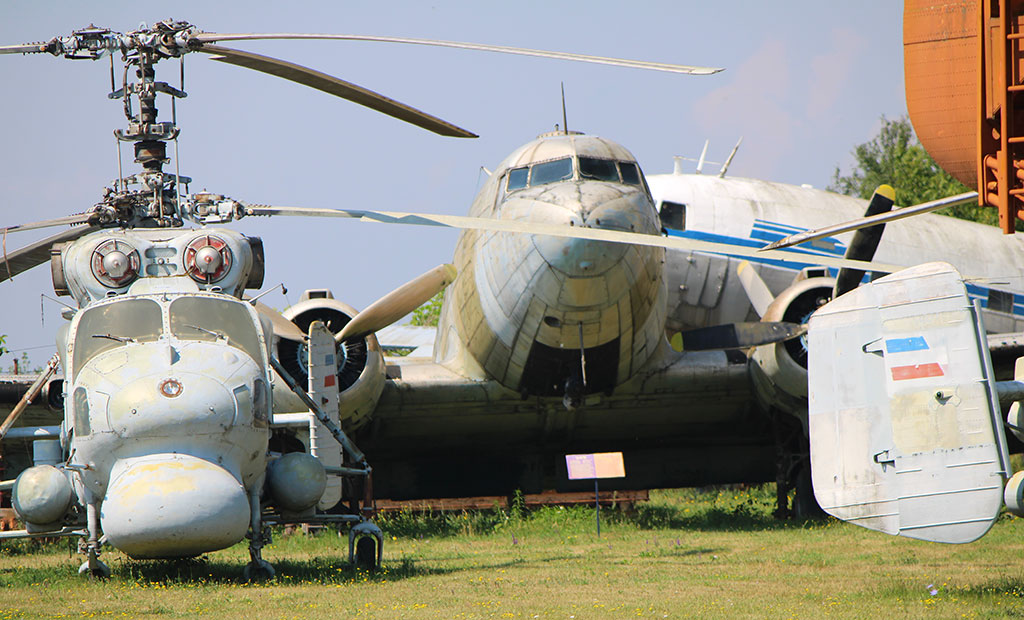

We are familiar with Short Brothers and their long association with building fine aircraft, but the Short Sealand had evaded me during my many years of spotting and a trip to the Aeronautical Museum in Belgrade would put this anomaly to rest. The type first flew in 1948 and in many respects looks unsurprisingly like other amphibious twin engine aircraft of the time such as the Grumman Mallard. The example on display in Belgrade was one of two such aircraft delivered to JAT in 1951 and was deployed on passenger services linking coastal towns along the Dalmatian coast. It finished its flying career with the Jugoslav military whose colours it wears today. The aircraft appears to be in good order, although you may notice that the aircraft appears to be located beneath a nest and is now sadly wearing a thick coating of bird droppings!
In addition to the Short Sealand there are several other Western aircraft types on display including a DH Dove, DHC Beaver, 4 Douglas DC-3/Li2s, and a former JAT Caravelle III. Several of the DC-3s and many of the other aircraft in the open are in a severe state of neglect and the site is more akin to what I would refer to as a bone yard rather than a museum. Despite their condition, one cannot help but warm to their appearance which made the visit all the more rewarding. It was also the first time that I had ever come across an opportunity to photograph an Ilyushin IL-14, Douglas DC-3 and a Junkers Ju-52 neatly arranged in line!
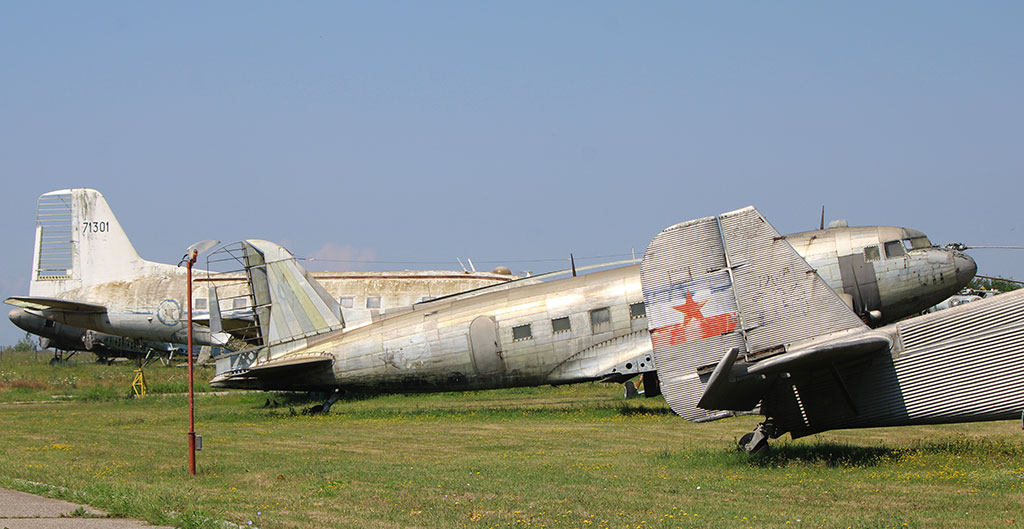
When shall we three meet again?



Not only do the aircraft look worse for wear, but so does the magnificent futuristic looking museum building and I fear for the future of both. During the two days stopover in Belgrade, we discussed the Museum with various locals all of which knew of the facility but without exception none knew of it being closed. Here in lies the problem, it would appear there is little local appetite to visit the museum. I am so pleased that I visited Belgrade sooner rather than later and I do hope the new owners can find a way to give this superb collection of nationally important aircraft a new lease of life.
Mr Jones and I knew before departing the UK that the Serbian authorities have adopted a rather adversarial approach to aircraft spotting and the taking of photographs is frowned upon especially so in and around the cargo ramp adjacent to the perimeter road. We had learnt upon arrival in Belgrade that the terminal layout is conducive to spotting with unimpeded views over most gates and ironically the “sensitive” cargo and executive areas. With this in mind we decided to defer our airport spotting duties until we returned airside for our flight to Frankfurt on Saturday.
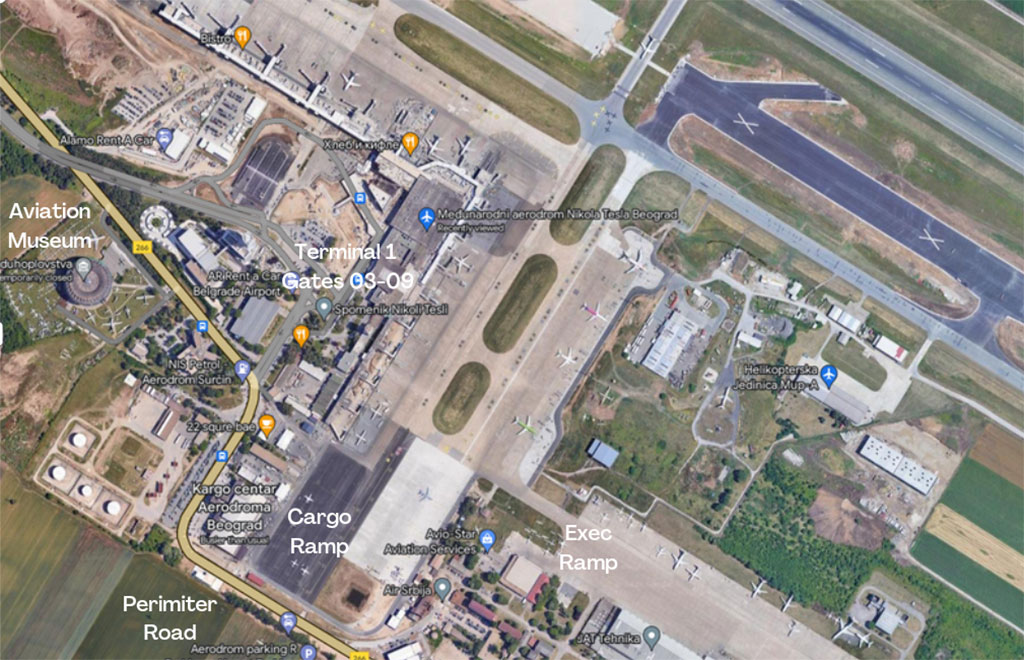
Belgrade airport map
Having spotted the Short Sealand we headed for our hotel which was located in the centre of what turned out to be a most charming, welcoming and importantly historic capital city. With regards to a more recent historical event, I took the opportunity that evening to visit the Palace Metropol Hotel to undertake a spotting mission of a different kind. In February 1958 the visiting Manchester United football team stayed at the Metropol on the night before their ill-fated return flight to Manchester via Munich. Whoever you may cheer on match day, their memory will always be a blessing to the beautiful game.
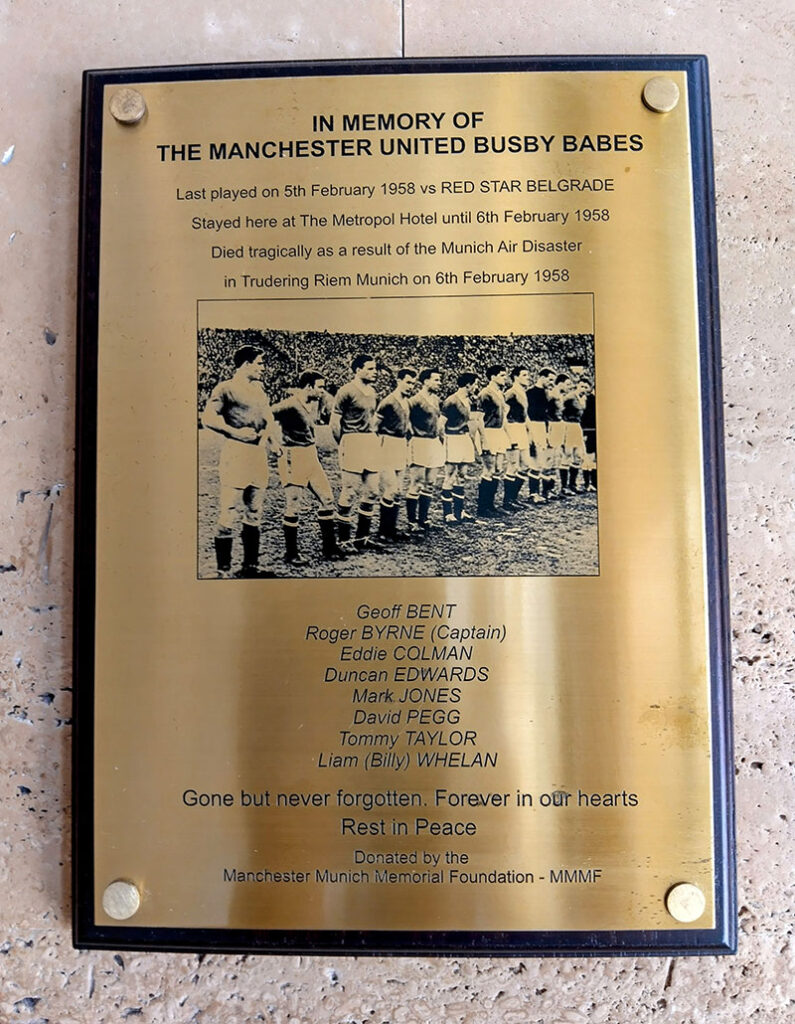
In memory of the Busby Babes
Saturday 29th June: Belgrade to Frankfurt
The short road journey from the city centre to the airport provided a stark reminder of the turmoil this region has endured during the last 40 years, with numerous slogans referencing Kosovo, Sarajevo and Putin scrawled across the motorway furniture.
There was also a sense of jeopardy in the rental car as we had decided to swing by the cargo ramp to see if there was anything of note parked up. Fortuitously, Aruba registered Embraer 190 P4-BFE of Angolan operator Bestfly was preparing for departure. The following two photographs were taken from the perimeter road adjacent to the cargo ramp. Should you visit Belgrade airport, please be mindful not to stop your vehicle or to linger on foot too long at the aforementioned location.

With the rental car successfully returned we checked in for our flight to Frankfurt and proceeded air side for 3 hours of spotting, albeit through glass. The mix of airline tail fins across the airport was impressive and during the 3 hours spotting I logged 6 new airlines. Gate 07 is positioned directly opposite the mosh that makes up the executive aircraft ramp. Beyond the executive ramp there is a line of stored airliners, including former JAT Boeing 727-200 YU-AKF. The line also included Great Dane Airlines Embraer 195s OY-GDB and OY-GDC, both in full Air Serbia Livery.
The executive jet community was largely made up of a wide variety of small to medium sized types, a pleasant change from the airliner-esque Gulfstream and Bombardier aircraft that normally frequent airports on our bread-and-butter spotting excursions.

In addition to the large number of locally registered “YU” prefixed Cessna and Embraer executive jets, there were examples from the neighbouring countries of Croatia and Slovenia. Making a very brief visit to the airport was the Government of the Republic of Serbia Cessna CJ4 E7-GPS, as did San Morino registered Airbus A318CJ T7-7777. The latter is one of only 20 manufactured by Airbus and a type that I did not expect to spot on this trip and by chance still required as part of my Challenge.

The list of destinations served from Belgrade is fascinating, many of which were new to me and some that are no longer available from British and EU airports; Sochi, St. Petersburg and Moscow to name just a few.
Some aircraft earn a special place in a log book because they are rare, others because they are very different. On both accounts Belgrade airport delivered but especially so with regards to the very different “4 engine” piston powered aircraft parked next to a derelict former JAT DC9 32. This 4-engine conundrum is in fact the former JAT Convair 440 YU-ADO. The aircraft was damaged beyond repair in a wheels-up landing in 1971 and later “modified” with 2 additional engines for use in a local film production.
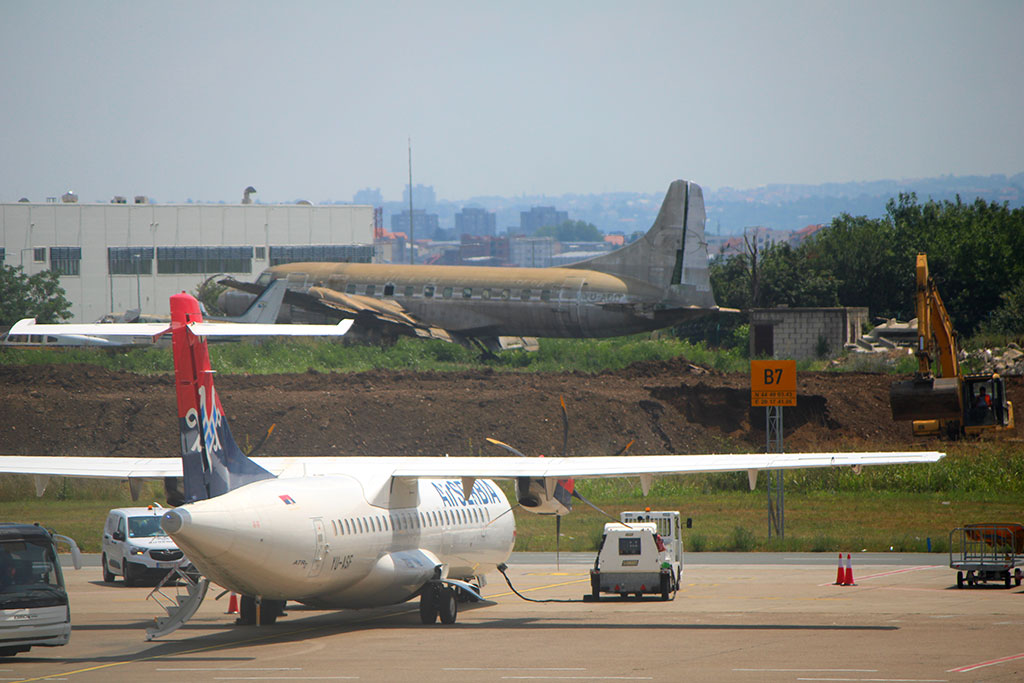
YU-ADO – the four engine Convair 440
I really enjoyed spotting at Belgrade airport. Despite the museum being closed, we were not too inconvenienced and being able to “look but not touch” added a different dimension to the task of spotting the museum exhibits huddled around the magnificent looking Geodesic building. Belgrade airport certainly proved not to be an open book and we were most pleased to log the BestFly Embraer 190, especially so as this was only its second sortie out of Africa this year.
The intimacy of a small busy airport had its rewards, and despite not being particularly “spotter friendly”, we kept our course, remained discrete and by doing so were able to spot and photograph a wide selection of exciting aircraft and new airlines. It was also rewarding to spot a “small” Qatar airliner which made a welcome change from the company’s wide bodies that frequent the major airport hubs. The following photographs were taken from departure gates 03 to 09, all of which are accessible to airside passengers.



Our departure time arrived and we boarded Lufthansa Airbus A319 D-AILD for Frankfurt. No meet and greet today, but we were “welcomed” in kind by graffiti scribbled on the fuselage next to the forward passenger door. Before heading for Belgrade that morning, the aircraft had flown into Frankfurt from Dusseldorf and we were informed that an inbound passenger from Dusseldorf had hastily written their own welcome message on the side of the aircraft when disembarking. I think it would be fair to say do not try this at home. The culprit also needs to brush up on their German geography.
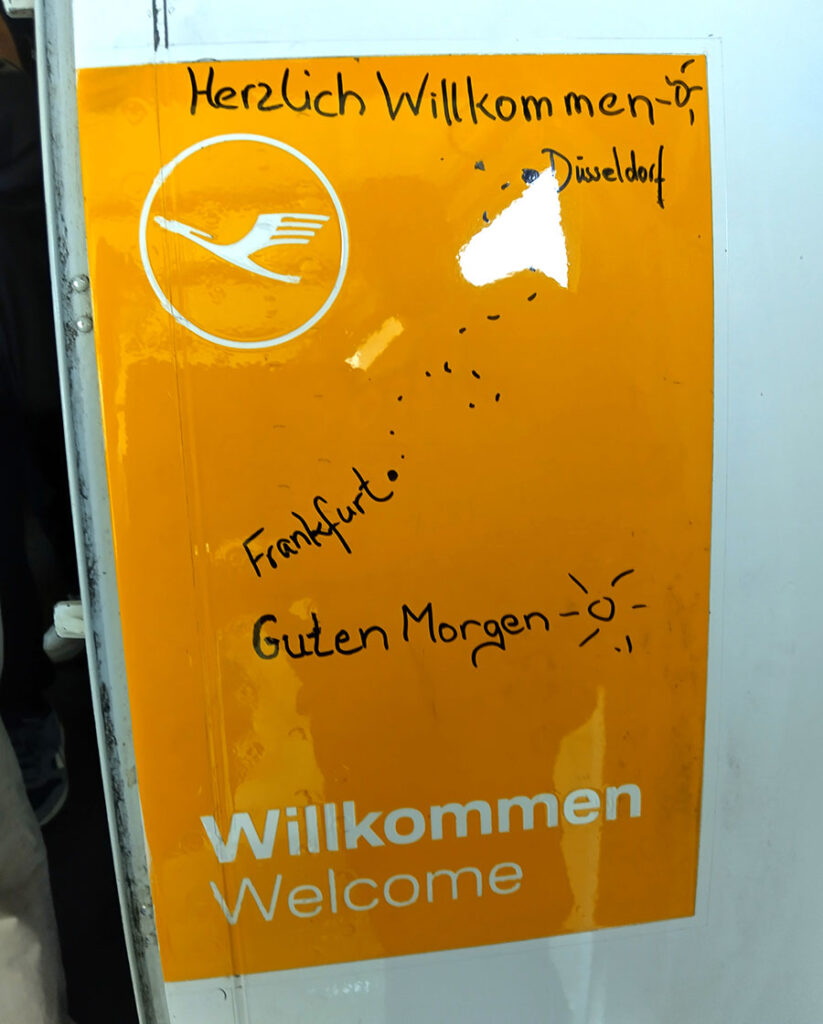
Graffiti adorning Lufthansa Airbus A319 D-AILD
Fussball Frenzy
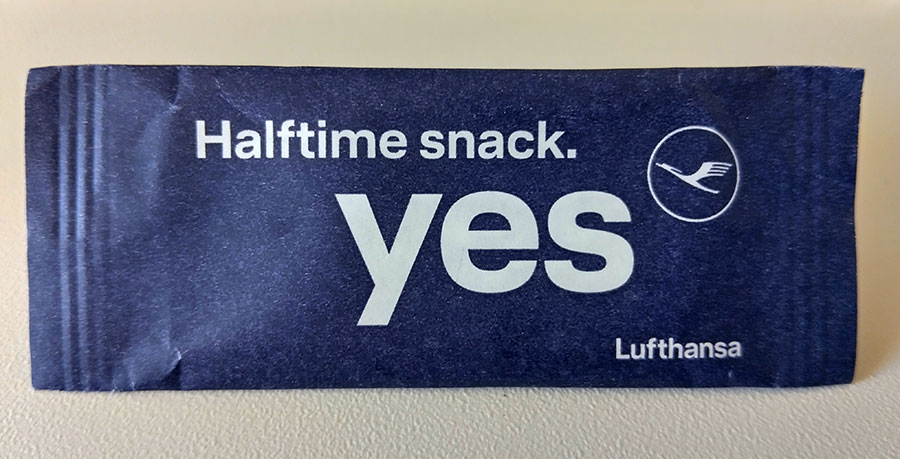
Lufthansa in flight “half time” snack
After a 1 hour 40-minute flight we touched down at Frankfurt only to learn that our preciously small spotting window had been shortened due to our aircraft having been selected by the local police for a full passenger check. This took some time but the dark clouds that had begun to arrive over Germany fortunately had a silver lining. Parked directly in front of our Airbus A319 was Royal Jordanian Embraer 195 E2 JY-REC which I hastily photographed with my mobile phone from inside our transfer bus. Royal Jordanian aircraft are frequent visitors to the United Kingdom but this was my first of the type operated by the airline. It was also only the second time that the aircraft had visited Germany since it was delivered new to the airline in April this Year.
There are acres of editorial content covering the many airlines and aircraft types to be spotted at Frankfurt airport, so I will limit my report and photographs to include only the resident quad jets which after all were the reason for visiting this renowned plane spotter’s dream. With less time now available for spotting, my major concern was had the quad jets flown the coup?
Not surprisingly the airport was caught up in European Championship football fever and many of the airport staff were adorned in the German national team shirt. Taking the bait and fancying our football prowess, Mr. Jones and I indulged ourselves by taking part in a penalty shootout competition. Much to the amusement of the local German onlookers we both scored and were rewarded with a small gift from the Duty-Free shop.
With insufficient time to take advantage of the public spotting terrace located in Terminal 2, we embarked upon what felt like our own version of “supermarket sweep” and found every vantage point possible in Terminal 1 to do some spotting. From a quad jet perspective, the number of aircraft spotted did not disappoint. Numerous Boeing 747-400 and -8 variants in both passenger and freight formats were logged, and not all belonging to Lufthansa. As for the Airbus A340 family, I was fortunate enough to log both the -300 and -600 variants all looking splendid in the latest Lufthansa livery. Unfortunately, the Lufthansa A340-600 was parked too far away for photographic purposes but it is etched for eternity in my log book.
At the last minute our departure gate was changed and everyone was instructed to relocate from gate 19 to gate 27. What I didn’t know was that a Lufthansa Boeing 747 had recently arrived at the stand adjacent to our awaiting Lufthansa Airbus A320neo. As we queued in line to board with the other passengers, I could not help but notice that it was not just the two spotters who were staring at the aircraft parked just meters away. Mr. Jones broke the silence and commented that in all his 50 years of plane spotting he could not remember seeing the nose section of a Boeing 747 so close up and from such an iconic angle. Coming to think about it, me neither. It is 54 years since I spotted my first Boeing 747 but this mythical aircraft still turns as many heads as it did back in 1970. Coincidently the following photograph proved to be the last one taken on this spotting trip.
Auf wiedersehen quad jets
Spotting the sporty Convair 990 in Lucerne, the elegant looking Short Sealand and the relatively rare Airbus 318CJ in Belgrade dutifully delivered 3 more aircraft types that could be removed from the Challenge list. From a traditional spotting perspective, I logged in excess of 400 aircraft at Zurich and Belgrade alone and spotted 12 new airlines across all 3 airports. Plus, there was the added bonus of flying on a new aircraft type, the Airbus A220-300.
From a quad jet perspective, the number of types logged unexpectedly exceeded my pre-trip target of 6. Not only did I spot a Boeing 747-400, Boeing 747-8i, Airbus A340-300, Airbus A340-600, Convair 990 and Airbus A380, but I also stumbled across a seventh type. When departing Frankfurt our aircraft taxied past a former WDL BAe 146-200 now used by N-ICE GmbH for de-icing training. It felt good to be reunited with this particular jet as I flew on it from Luton to Munich via Dusseldorf in 1997 when in service with Debonair. Frankfurt airport really is a living monument to the continued survival of quad jets.
As for the older quad-jets spotted on this trip, how long until 4 finally becomes 2? The Lufthansa Holding Group has announced their quad jet replacement plans and has already placed orders with Boeing and Airbus. Commencing in 2026, Lufthansa’s Boeing 747-400 passenger aircraft will be replaced by the Boeing 777X. The Lufthansa Airbus A340 fleet will be replaced by a mix of Boeing 787-9 and Airbus A350-900 aircraft over the next few years, deliveries of which have already commenced. As for the Airbus A340 aircraft operated by Swissair and Edelweiss, the Airbus A350-900 has been selected to replace both fleets with the first aircraft for Edelweiss arriving later this year.
So, there we have it, just a 2-to-3-year window remaining to spot the older passenger quad jets referenced in this trip report. Thank fully in the hands of Lufthansa, the 8i variant will most likely grace airports around the globe for some years to come. The Boeing 747 is not immortal but when the time comes to retire the last example, I am sure Lufthansa will find a solution to keep the “jumbo” dream alive.
News that a number of the Korean Airlines Boeing 747-8i fleet have been acquired to replace the existing fleet of US Air Force Boeing 747-200s (VC-25) is most pleasing. Should the US Air Force operate the Boeing 747-8i in this role for as long as they did the current incumbents, then we may well see the Boeing 747 carrying US presidents to airports around the world some 80 years or more after the type first entered service in January 1970.
As for the continued longevity of Airbus quad jets, it is encouraging to hear European Cargo’s recent announcement that it has purchased 3 additional Airbus A340-600 aircraft and that they will be operating out of Bournemouth airport on cargo duties before the end of this year. I feel a trip to the coast will soon be warranted.
Departing Frankfurt my thoughts moved on to Farnborough which was the next aviation event in my calendar, and the opportunity to spot a few aircraft types belonging to the next generation of airliners. At least spotting is coming home, sadly the beautiful game boarded a flight to Madrid.






3 comments
Hi John , great mini trip indeed , have been to ZRH a few times on various SR types , only had a transit once in BEG and quite a few times at FRA
Spotted my first PANAM 747 6Feb 1970 , N735PA and my first flight in one July 1971 LAX/LHR. Used to love watching the trans Atlantic. 707, DC-8 and VC-10 from my home in Belfast in the 60s. Had lunch on a SAS CV-990 at LHR in 1965 and lucky to see quite a few over the years.The Short Sealand would have been my top prize as only 3 left , one in Belfast(in bits) and the other in India . Great photos , great trip and a good read
Thank you
Merv Crowe Perth AUS
Thanks for a great article and the superb pictures. Seeing the beautiful Swissair 990, reminded me of my only Convair jet flight, not on a 990 but an earlier similar 880, from Okinawa to Taipei and Kai Tak, Hong Kong in April 1963. This was Civil Air Transport’s (CAT) only jet aircraft (B1008) and was superbly decorated internally with Golden Chinese dragon motifs. Surprisingly, a good friend here in Reno, who was a 707 Captain with Global Airlines, also flew on this same airplane to Hong Kong. CAT was an American airline owned by Air America, and based in Taipei. Another interesting Air America flight was on a several Southern Air Transport MATS Contract DC-6Bs from Tokyo to Okinawa, Clark AFB P.I. and return in Feb 63. I was so lucky to have experienced such interesting days in aviation.
Amazing memories John! Do you have any pictures from those days?
Matt